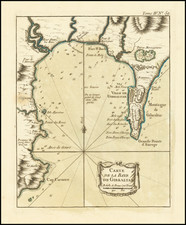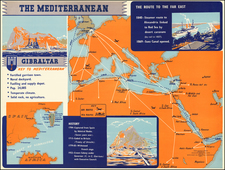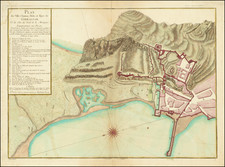The Beginning of the Great Siege of Gibraltar
Rare first state of this topographical map of Gibraltar and environs, published by Guillaume Dheulland in Paris. Following the beginning of the Siege, the map would be revised to show battle progress.
The Plan Topographique de la Ville Port, et Baye de Gibraltar et de ses Environs, meticulously crafted by Guillaume Dheulland and published in Paris, offers a detailed image of the geography and layout of Gibraltar immediately before the renowned Siege of Gibraltar. It underscores the significance of strategic military positions and provides insights into the tactics employed during the siege.
Key places within the map provide a detailed snapshot of Gibraltar's defensive fortifications and essential structures. The map prominently features the Bastion St Pierre (3) and Bastion St Paul ou du Nord (4). Both bastions, given their prime locations and fortified structures, would have been crucial in warding off attacks and strengthening the city's defenses.
The Porte de la Terre (5) – or Earth Gate – stands out as an entry point that the British would have heavily guarded, understanding its critical role in both defense and communication. Similarly, the Porte de la Mer (13) represents another key gateway that would have facilitated access between the sea and the land. The presence of the Retranchement Royal (6) and the Retranchement pour soutenir la Brecke lors du Siege de 1727 (8) indicates the need to reinforce areas which were vulnerable or had been points of contention in previous sieges.
It is also important to note the presence of essential facilities like the Magasin (14), which was likely a storehouse for essential supplies, and the Hospital (15), which would have treated injured soldiers during the protracted conflict. The Batterie de la Princesse Anne (9) and Batterie de la Reine (10), on the other hand, further illustrate the robust defensive mechanisms in place, with cannons and artillery poised to defend Gibraltar's shores and city.
The map also uniquely highlights several historical landmarks. For instance, the Ruines du Bain des Maures (31) gives us a glimpse into Gibraltar's rich history and Moorish influence. The Tour au Diable, or the Devil's Tower, adds an element of local legend and lore to this militarily focused chart.
Great Siege of Gibraltar
The Great Siege of Gibraltar was an unsuccessful attempt by Spain and France to capture Gibraltar from the British during the War of the American Revolution. The American war had ended with the British defeat at Yorktown in October 1781, but the Bourbon defeat in their great final assault on Gibraltar would not come until September 1782. The siege was suspended in February 1783 at the beginning of peace talks with the British.
On June 16, 1779 Spain entered the war on the side of France, attacking the British base at Gibraltar was Spain's primary war aim. The vulnerable Gibraltar garrison under George Augustus Eliott was blockaded from June 1779 to February 1783, initially by the Spanish alone, led by Martín Álvarez de Sotomayor. The blockade proved to be a failure because two relief convoys entered unmolested—the first under Admiral George Rodney in 1780 and the second under Admiral George Darby in 1781—despite the presence of the Spanish fleets. The same year, a major assault was planned by the Spanish, but the Gibraltar garrison sortied in November and destroyed much of the forward batteries.
The besiegers were reinforced by French forces under de Crillon, who took over command in early 1782. After a lull in the siege, during which the Franco-Spanish besiegers gathered more guns, ships and troops, a "Grand Assault" was launched on September 18, 1782. This involved huge numbers—60,000 men, 49 ships of the line and ten specially designed, newly invented floating batteries—against the 5,000 defenders. The assault proved to be a disastrous failure, resulting in heavy losses for the Bourbon attackers.
This was the largest action fought during the war in terms of numbers.










![[Manuscript Map of Gibraltar]](https://storage.googleapis.com/raremaps/img/small/66061.jpg)

![[ Gibraltar ] Plan du promontoire de la ville et du port de Gibraltar avec les ouvrages faits depuis le dernier siège et les lignes construites par ordre de sa Majesté très catholique, pour empescher la communication de Gibraltar avec l'Espagne : levé nouvellement sur les lieux par l'ingenieur de la place.](https://storage.googleapis.com/raremaps/img/small/98510.jpg)

